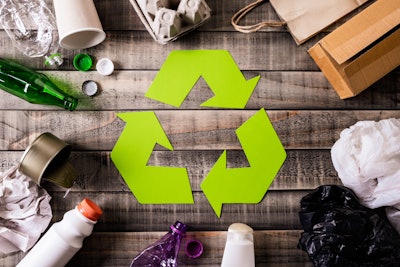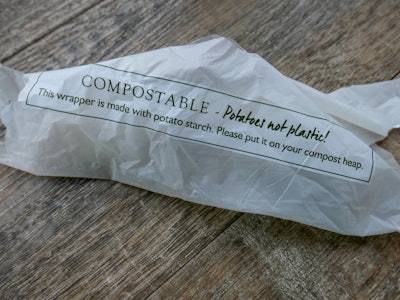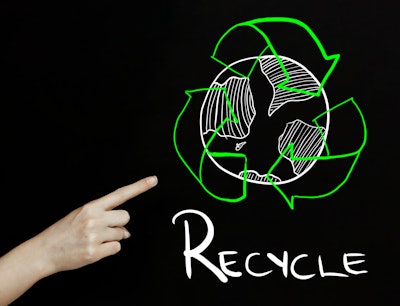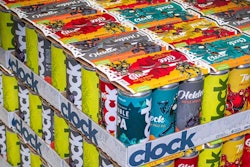
On day two of the New Hope Network’s virtual Spark Brand Success event, a panel of sustainable packaging experts (from start-up to emerging brand to large corporation) discussed their company’s journey with sustainable packaging –– with both successful, and not-so-successful results. Read part of the conversation below (edited for length) that includes topics such as plant-based materials, compostable packaging, infrastructure, using less packaging material, and top considerations when making sustainable packaging choices.
Plant Based Materials
Paloma Lopez (CEO at Future Fit Foods):
Future Fit Foods is a food startup out of Boulder, Colorado, and we're going to bring in a new generation of real plant-based foods that are convenient, affordable, and nutrient packed to people. And we want to do that in a way that is plastic-free, as well. We spent all of 2020 searching for different packaging solutions. We spoke to startups that are working on breakthrough packaging; seaweed, and other types of new materials, primarily plant based.
Read: Flax4Life Up to the Challenge of Switching from PE to Plant-Based PLA Material
Read: Vegan Ice Cream Rebrands, Uses 100% Plant-based Packaging
Our stand is that we need to really think about what the packaging is that is really going to nurture our planet and people into the future, which really means thinking about regenerative for more circular systems. Which to us, are primarily plant-based packaging, or reusable packaging.
Compostable Packaging
Kate Flynn:
I'm the co-founder and CEO of Sun and Swell. At Sun and Swell, our goal is to make healthy and sustainable eating more accessible for everybody. And we do that through our line of organic, plant-based healthy foods and plastic repackaging. So, I think our stance on plastic has evolved throughout our journey. I'll just quickly walk you through our history with it, and how my perspective as a founder, and our business, has been shaped based on packaging.
When we started the company several years ago, we were really just focused on bringing healthier food to people. I wasn't even thinking about sustainable packaging, honestly, when we first launched. We launched our product, we had it on shelves, and we realized we were solving the problem of health, but then contributing to the problem of single-use plastic. I got really obsessed with trying to figure out a better solution. I discovered compostable packaging exists. I realized nobody was selling their products in compostable packaging, even though the technology exists. And I just assumed nobody wanted to sell it in compostable because of cost. I didn't think that there might be other reasons. And I just made a quick decision; we're making the switch to compostable, and I dove right into it. We tried to transition our entire product line over to compostable packaging.
Read: Home Compostable Bags for Zero-Waste Beauty Brand
At the time we did this, this was back in 2019, we were primarily a wholesale business, and got our products in compostable packaging on shelves and pretty much failed. We had a lot of challenges. The appearance of the packaging itself, the way it was holding up, it just didn't look good next to plastic packaging, which means consumers thought it was old. They didn't know it was eco-friendly. And we just had a lot of issues with it in wholesale. And I felt like I had to make the decision as a founder of an emerging business.  An example of compostable packaging
An example of compostable packaging
So, I decided I either need to stay out of plastic-free packaging for now, focus on everything else, and then try to integrate plastic-free once the technology improves a little bit. Or we need to shift our business model to accommodate plastic-free packaging if that's our number one thing; to really help transition the industry away from plastic. And we ended up going with the latter. So, over the past year, we spent our entire year basically transitioning our business model to accommodate compostable packaging where it is right now. That means shifting from a wholesale to direct to consumer (DTC) brand, and some other things as well.
Read: Compostable Overwrap for Tea Bags
For us, it's literally one of the number one things we're focused on. But I had to make a really, really, strategic decision to do it that way. And I always encourage brands to think about ‘where does compostable plastic-free packaging fall along your value prop?’ And if it's not number one or number two, it's not just a check the box thing that we can quickly do. So that's a little bit about our journey.
Alyssa Harding:
I am the Packaging Collaborative Lead at OSC2, and our work focuses on scaling compostable packaging solutions for the food industry.
One thing I always think about with compostable packaging is 6% of our global greenhouse gas emissions are associated with food waste. And it's closer to 25% of our greenhouse gas emissions within the food system supply chain. So not only can compostable packaging help you as a climate solution, but it also supports the reduction of plastic proliferation in the environment.
Infrastructure
Eric Klingenberg (Lead Material Science for Mars Advanced Research Institute):
We focus in three areas: healthy planet, thriving people, and nourishing wellbeing. And our plastic packaging sits under healthy planet. And so, if you haven't seen it in the news, we just went 100% renewable energy in Australia as of this year.
We're really focused on reducing greenhouse gas where we get our power from. Our goal is to have 100% reusable, recyclable, or compostable packaging. But we realized, the answer is not the same everywhere in the world because we have different infrastructure. We have different supply chain needs. And my role really sits at how do we leverage new materials and accelerate the development of new materials so that our packaging can be reusable, recyclable, or compostable in these regions? And what fits best? And so, in packaging, I think we've learned to take a more holistic approach than we have in the past.
Read: RLC Releases Report on Fixing Recycling in the U.S.
And so how do we advocate for infrastructure so that we have the right infrastructure in place, and it fits with the local economies and the systems? And then designing our package to fit within that infrastructure. And probably lastly, we, each and every one of us, plays a crucial role in this. Are we putting our plastic packaging in the right place? We're the first line of defense, really. Are we sorting properly, even if they're recyclable? And so how do we do that? And how do we focus on education and clear labeling and guidance so that it makes it into the right spot? 
Alyssa Harding:
To Eric's point, there's no silver bullet solution for your packaging. And when you're thinking about plastics, there are ways to use less plastics, use better plastics, incorporating post-consumer recycled content or bio plastics into the mix, and eventually no plastics. And making the transition to something that has a more renewable plant-based feedstock.
That being said, what do you see as the top considerations for companies as they choose their packaging materials and structures?
Top Considerations
Paloma Lopez:
There's a model that I really like, and I apply it often for a lot of decision-making, which is the ideal trifecta model. Essentially it looks at desirability, feasibility and viability. Desirability is really a human-centric approach to what people desire; what people need. When we look at packaging at Future Fit Foods, we thought about, ‘let's pay attention to what the trends are, what people want to see in their packaging.’ And what we're seeing is, people are still looking for convenience. So that hasn't gone away, but that does not mean single-use packaging. It doesn't mean plastic. It doesn't mean any of those things. It just means convenience. If you bring it to me, and I can reuse the packaging, that's great. So convenience is definitely still top of mind, and whatever packaging we choose, that needs to be there.
There's an increasing obsession with waste in younger generations. They think now that we're all getting a lot more packages at home and we're starting to feel a little overwhelmed with packaging. So, in our research at Future Fit Foods, we learned that waste is really top of mind, packaging waste. People don't like when things get wrapped three times, or they come in a bag and then in a box and then in another box. And it's definitely been a consideration for us. Where can we remove packaging? How can we come across as being very mindful of the amount of packaging we use?
The second aspect of this idea model is feasibility. When we looked at our packaging, the things that we learned through the journey was the importance of the barrier properties of the material. So plastic and multi-layer films that exist in flexible packaging in food today, most of them have really good barrier properties. That's why they've been used for a long time. And so what that means is that oxygen is not going to spoil your food, and humidity, it's going to be protected. So we need to transfer those properties to plant-based materials, and other materials that will be composed of, or be part of, nutrients to the system.
And so what we have found is that of all the options of plant-based, some perform better than others. So it's really important to become educated on the topic of barriers, as I have learned. Because that determines your shelf-stability, and, of course, in some cases, safety, but in other cases, it's just the quality of the experience, food experience, people are going to get.
And then under facility, there's also another aspect, which I've also had to learn the hard way, which is what packaging machinery does your co-manufacturer, or whomever you're working with, actually have available? If you're working with someone who's helping you make the food, you are limited by what packaging machinery they have. And so sometimes, some of these new plant-based materials require a lot of testing to make sure you don't stretch them too much, or that they don't shrink. So, there's a lot of learning that happens through prototyping as well.
And finally, the third aspect of this innovation model that I use is viability, which is economic viability. And so this is the cost aspect of ‘is it possible to bring forward all their materials?’ And I have to tell you that while it is for sure more expensive than plastic and a multi-layer material to go into plant-based, we're talking cents. We're not talking dollars. We're talking cents for the most part. So that is not the biggest issue of the shift to make. It's, like Kate was saying, viability, or even desirability. So it's the two other aspects, actually, that are much more critical than, I think, cost-viability. So from that perspective, I think the top considerations for us at Future Fit Foods is really thinking through this lens of what's desirable, how do we eliminate use waste, what is the perception consumers have had? How can we change the narrative in the story to its feasibility? How do we think about shelf-stability? Becoming educated on the barrier properties of packaging. And three, viability, of course, needs to be baked into the PNL of the brand.
Alyssa Harding:
That was great, Paloma. And I think, too, Kate can speak to some of the challenges around the operationalizing of the sustainable packaging transition. We have our goals, we have ROI, we have buy-in from different stakeholders, but there are challenges when you're trying to make a systems-level shift. So, Kate, I'd love to hear your perspective on the question. And what do you see as those top considerations?
Kate Flynn:
Everything Paloma said is so important, especially as my perspective is coming from a founder, and then from a small emerging brand. And I think we're so quick to just assume we can do everything. And sometimes, I wasn't as thoughtful when I launched my packaging in stores really quickly. And so that failed because I didn't take the time to think through all that.
But I think from an emotional standpoint, there's just a few other things - from an emerging brand perspective - that you really need to think about when you're thinking about sustainable packaging. You need to think about ‘where does this fit in your strategy? And is it a non-negotiable?’ It's easy to say, "Oh, I have six non-negotiables, and one of them is sustainable packaging." You really have to decide where it is on that hierarchy. And is it number one or two? Or is it number six? And I think that, for us, we came to a pivotal moment where we said, we either want to be known for plastic free, and we are transitioning to accommodate this, or that's not whatever we're trying to be known for. Or it's not within the top three things that we care about.
It doesn't mean if there was not an infrastructure today, that we can't be thinking about it, caring about it, and making progress towards it. But we need to be thinking about it, and I get questions from our customers all the time about the end of life of our bags, all the time. To the point where we actually have launched a send-back program, so customers can send their bags back to us. And we can compost for them. This works for us because we're a small brand. It would not work for Mars to do that overnight. We can do that because of the size of our company. But the educated customers, who actually care about that piece of your value proposition, are educated, are going to care. And so you need to be thinking through that entire piece of it yourself so you have the answers, and are thinking about how your business model is going to lie.
Alyssa Harding:
Infrastructure development, and the corresponding consumer education, are two essential pieces outside of the design and material due diligence. And at OSC, we just started a partnership with the Compost Manufacturing Alliance and the US Composting Council to bridge the gap in infrastructure expansion there. 4% of the country has access to an industrial composting facility, which can be a limiting factor when folks are considering a transition to compostables. But when you also have that other fact of 9% of plastics have actually been recycled, you know that the food system provides a very unique solution for helping to address the plastic crisis. I'll throw it to Eric for your top considerations and hear the more enterprise-level perspective on scale and development.
Read: Five U.S. Packaging Bills Under Consideration
Eric Klingenberg:
As big companies, we can't do it ourselves either. I think Jenna's heard me say this; it's a team sport in innovation, and how do we do this? Because we all need to come together, in reality, to help push things forward. We need to look at the materials' platforms and then pull them in together as well as the infrastructure and education that would be consistent across, no matter our size.
When we look at it, we think of things that are not one or the other, and they're not above each other. They're equal. And so, food safety and quality come in there. And if we're not delivering safe, high quality food, it doesn't make sense to switch.
Secondly, the consumer experience. And that consumer experience for me includes not only ‘what is your experience with our products and our packaging, but will it get to the recycling facility? Will you do the right thing with it?’ But lastly, it's not ‘plant-based,’ and it's not ‘anti-plastic.’ It's ‘are we sustainable?’ And so there are a lot of technologies out there that I would say are being touted as things that are really good. These are plant-based. And if they're not sustainable and healthy for the environment, then we shouldn't be moving to them, or we should figure out a way to make that move.
We have programs now, not just to consider ‘is it recyclable, is it a compostable, but what are all the additives?’ We're digging down into the package for every chemical component that's added. Is it recycling? Is it safe? And if it's compostable, making sure it doesn't contain P phosphate. What are the other types of materials we have to have in there? And then you said it with infrastructure. And I can say, it's been a wonderful conversation. And I've had a great opportunity to talk to many composters and tour sites.
We don't want to be a contaminant for them either. So just saying our plastic packaging is compostable, and we pass the standard, doesn't mean they operate that way. So how do we have the right level of conversation? And how do we design more towards where they operate? How do they operate towards what we can handle? It's an ongoing conversation that we're having across the value chain now that we haven't had maybe in recent past. Really, I think that's the bigger picture of great trust, is safety, quality, making sure that we're not just a recyclable, but we're sustainable in that. The last thing we want to do is to do harm for the environment, just to say we're recycling. That's not a good place to be in either.






















